While researching and writing about the history of Boston Partners in Education for this “50 Years, 50 Stories” series, we’ve learned a lot from our former volunteers and employees. One of the most surprising things we’ve found is that, despite the need for constant innovation, there has been a decades-long tradition of turning to past generations as a source of knowledge and inspiration for the future.
Beginning in the 1970’s and running for many decades in many different forms, the Intergenerational Program of School Volunteers for Boston (now Boston Partners in Education) sought to connect students with the knowledge and experiences of senior citizens in their own community. The Intergenerational Program was the first of its kind in the city, and it influenced others in the National School Volunteer program to emulate it nationwide.
The Intergenerational Program began in 1974 with the support of Boston’s business community, the Boston Globe, the Hayden Foundation, and the Executive Office of Elder Affairs. It sought to join students with senior citizens in every aspect of SVB’s programs and partnerships. This expressed itself in countless ways.
In the 1970’s, an elderly Italian woman taught English to a pair of Italian sisters, in connection with our focus on English as a second language (ESL) mentoring. For almost a decade, Rolline Evans returned to the same classroom at the Trotter Innovation School in Dorchester to teach piano and music. Joe Keegan, a jazz musician, shared his stories of growing up in the United States with elementary school classes. Students and seniors worked together as docents and volunteer guides at the Museum of Fine Arts. Students visited nursing homes to find out how they could help and what they could learn from the seniors there.

Rosaura Rios, Diana Rodriguez, and Licia Pitts pictured in the Intergenerational Program, November 19, 1977.
One student, Adam Yen, recalled his own experiences with the Intergenerational Program. A student of the Boston Latin Academy, he used the program to fulfill a community service requirement by helping an elderly Chinese couple translate their mail and medicinal instructions. “They always welcomed me and were very grateful,” Adam explains. “What I got out of it was learning how very similar they were to me and my parent’s background. The couple had been in the States for a while, and they had grown children. But what they struggled with was being first generation immigrants with a language barrier.”
Seniors benefited as much from the program as the students. It gave them a way to contribute meaningfully to the community and make new connections with the upcoming generation. Jack Gordon, a legally blind volunteer, reported to the Boston Globe in 1982 that, “My reward is when children from my classes run up to me on the street and greet me. The work is more fulfilling for me than the children.”
Ersilla Strazzula, who helped her Italian students with ESL work in the 1970’s to make sure they didn’t fall behind, shared a similar sentiment: “Tutoring has brought me a fringe benefit. My students are keeping me young.”
Under the direction of John O’Loughlin, the Intergenerational Program’s first director, students gathered oral histories from the seniors. This eventually produced the short book, “What’s in a Name?” which gathered and explained all of the names of every school in Boston. Many of those histories were lost in a fire, but copies of the book remain. The core concept of the Intergenerational Program survives today in other non-profits, such as Generations Inc.
While the program was nationally influential, it also changed the focus of School Volunteers for Boston, thus beginning the trends that define Boston Partners in Education. The Intergenerational Program seems to be one of the major reasons why SVB began to consider one-on-one mentoring to be the most beneficial and important aspect of volunteers in public schools.
The Episcopal Diocese of Massachusetts, one of the churches that provided a great deal of volunteers to SVB, affirmed the importance of the Intergenerational Program: “Of all the projects we have done, [the Intergenerational Program] has been the most successful. The warmth generated between students and residents is immeasurable.”
Indeed, there was more written about this single program than any other in the articles we have uncovered since beginning this research for our “50 Years, 50 Stories” series. The Intergenerational Program has fulfilled its goal once more: looking back to teach us where our ideas and values come from, and reinforcing those values moving forward.
